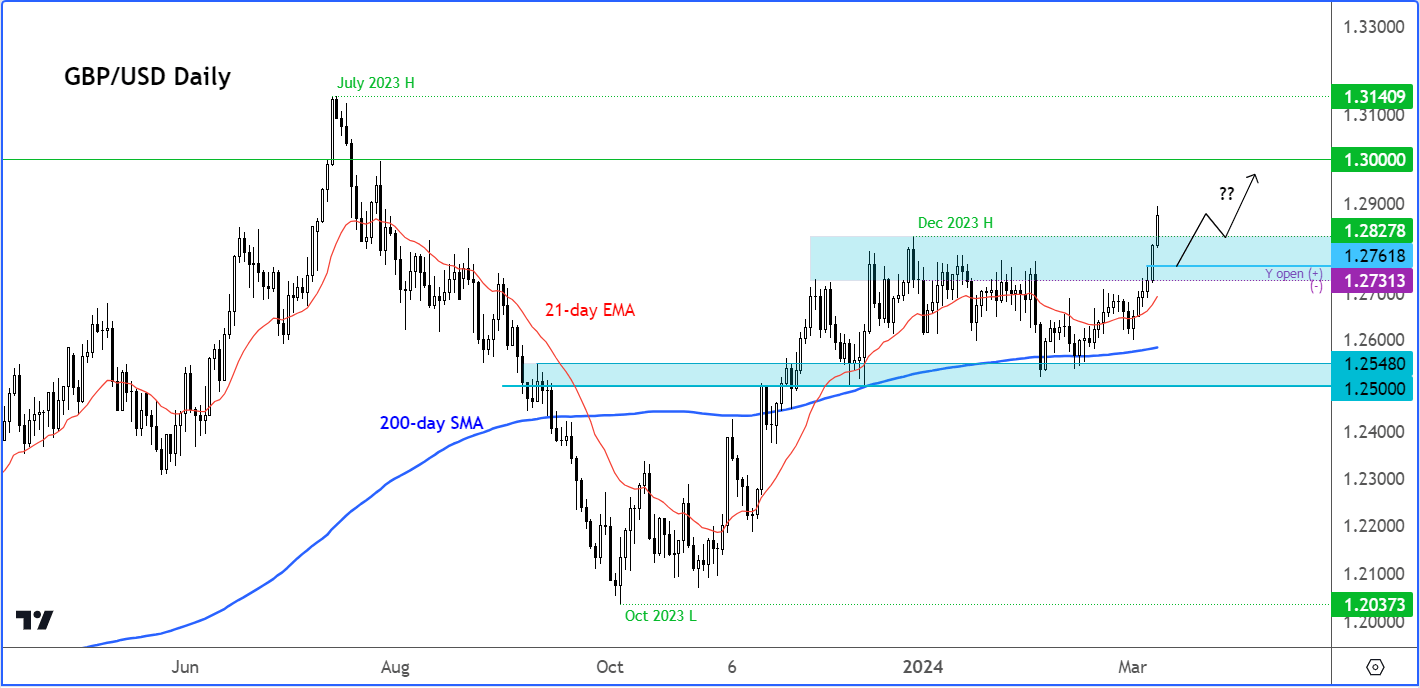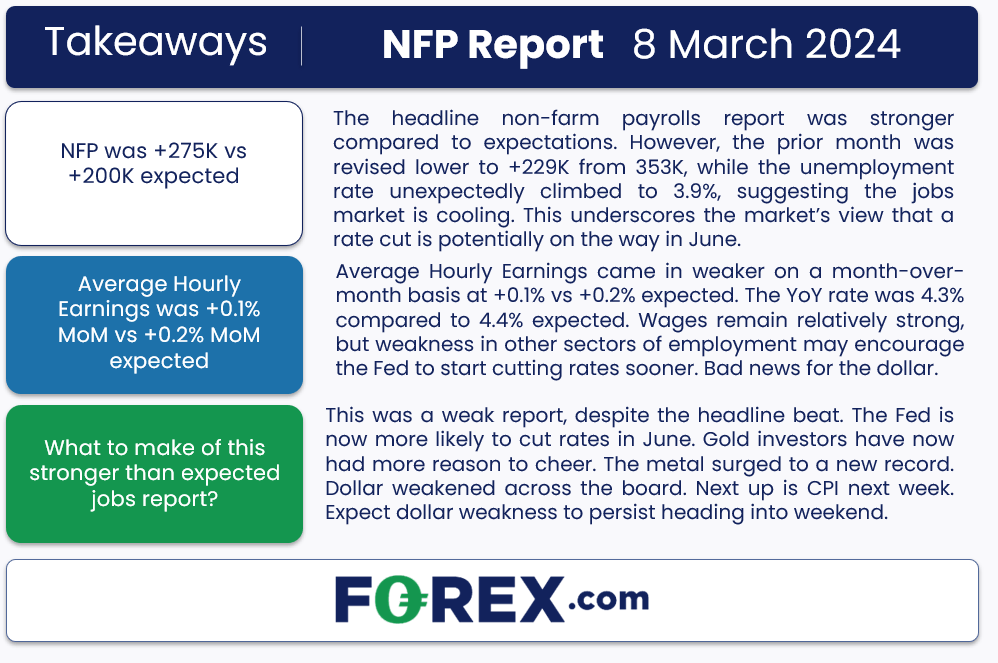
- GBP/USD analysis: Is the cable heading to 1.30?
- GBP/USD technical analysis point higher
- What’s next for GBP/USD?
Welcome to another edition of Forex Friday, a weekly report in which we highlight selected currency themes. In this week’s report, we will discuss the US dollar, upcoming data releases from the US next week, and why we think the GBP/USD is heading further higher.
This morning saw the GBP/USD extend its gains for the sixth day to hit a fresh 2024 high near 1.2850, reaching its best level since July 2023. The move was driven by continued weakness in US dollar, which helped to send gold to a new record high and underpinned all other major foreign currencies, most notably the yen and the antipodean dollars. After the US dollar’s sharp falls, attention had turned to the monthly US jobs report, which was largely expected to show moderate employment gains following the very strong January and December figures. As it turned out, the jobs report disappointed, despite beating on the headline front. This created fresh dollar selling. Next up is US CPI on Tuesday. I expect the dollar weakness to persist heading into weekend.
Before discussing the macro factors in great detail, let’s have a quick look at the chart of the GBP/USD, which is looking increasingly bullish.
GBP/USD analysis: Is the cable heading to 1.30?

Source: TradingView.com
With the GBP/USD breaking above several resistance in recent days, the path of least resistance is clearly to the upside. So, we will be looking for dip-buyers to step in on any short-term pullbacks to former resistance levels. These levels include 1.2828, the December high, followed by 1.2800 round handle and 1.2760, a previous resistance level.
On the upside, there are no immediate reference points until the July high of 1.3140. Ahead of this level lies the psychologically-important 1.30 handle, which is my main upside objective.
US non-farm payrolls mixed

Overall, this was a weak jobs report, despite the headline beat. The Fed is now more likely to cut rates in June. Gold investors have now had more reason to cheer, with the metal surging to a new record. The dollar weakened across the board, sending the USD/JPY to 146.50.
The headline non-farm payrolls report was stronger compared to expectations. However, the prior month was revised lower to +229K from 353K, while the unemployment rate unexpectedly climbed to 3.9%, suggesting the jobs market is cooling. This underscores the market’s view that a rate cut is potentially on the way in June.
Average Hourly Earnings came in weaker on a month-over-month basis at +0.1% vs +0.2% expected. The YoY rate was 4.3% compared to 4.4% expected. Wages remain relatively strong, but weakness in other sectors of employment may encourage the Fed to start cutting rates sooner. Bad news for the dollar.
GBP/USD analysis: Has the dollar formed a near-term top?
The dollar has fallen sharply this week, as the ongoing stock market rally buoyed risk-sensitive currencies, while comments from Fed Chair Powell suggested rate cuts are on the way. By Friday, benchmark 10-year Treasury yields had slid to a one-month low, and the dollar index was down for the sixth straight day. The mixed jobs report wasn’t able to arrest the dollar’s decline, or the equity market tally.
Today’s mixed-to-weak jobs report add to a growing list of US macro data which have disappointed expectations in the last couple of weeks. Among others, they have included the ISM services and manufacturing PMIs, factory orders, ADP private payrolls, UoM and CB consumer sentiment surveys, new and pending home sales, Chicago PMI, Richmond Fed Index, Durable Goods Orders and GDP.
In other words, the data surprise index in the US has started to turn negative, which partly explains the recent dollar weakness. Meanwhile, the surprise index for the Eurozone and China have been pointing higher. This has helped to narrow the gap between European and US 10-year real rates.
Looking ahead: What’s next for GBP/USD?
Looking forward to the week ahead, we have plenty of data from both the UK and US to influence the direction of the cable.
UK Average Earnings Index
Tuesday, March 12
07:00 GMT
Last month saw UK wages came in hotter-than-expected, fanning concerns that interest rates will remain in place for longer than expected. They rose 5.8% in the three months to December, while the previous month was also revised higher to +6.7%. If wages remained strong in January, then this could further support the GBP/USD as it will push back BoE rate hike expectations. In this case, we could see the cable climb towards the 1.30 handle. Meanwhile, we will also have the latest jobless claims data to look forward to at the same time, while a day later the monthly GDP estimate will be released alongside a few second-tier data such as construction output and industrial production.
US CPI
Tuesday, March 12
12:30 GMT
The US dollar will be in focus with key inflation data to come in the week, with CPI due on Tuesday and PPI on Thursday. Last time, CPI came in higher, printing +3.1% year-over-year in January vs. +2.9% eyed, albeit it slowed down from +3.4% the month before. Core CPI was also hotter. Yet, the dollar’s gains following the hotter-than-expected inflation data was minimal, suggesting investors are expecting CPI to weaken more profoundly moving forward. Will we see a surprisingly weak print this time? If so, this should be further good news for GBP/USD and precious metals.
US Retail Sales
Thursday, March 14
12:30 GMT
Both headline and core retail sales data disappointed expectations last time, and this contributed to the weakness we have seen in the dollar of late, with a few other macro pointers also pointing to a slowdown in economic activity. If further evidence emerged of a struggling consumer, then we could see the dollar weaken and stocks may also suffer after making solid gains in the initial months of the year. A very strong report is what the dollar bulls will be eying.
-- Written by Fawad Razaqzada, Market Analyst
Follow Fawad on Twitter @Trader_F_R




